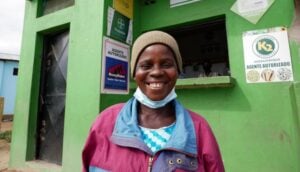Banana producers face an ever-tightening financial squeeze, caused by soaring export costs, plummeting import prices, climate change, Covid-19, supermarket price wars and the fusarium TR4 fungus. Add to this rising food prices and shortages of farming inputs like fertiliser, and you have a perfect storm.
These challenges threaten the prospects of smallholder banana farmers and agricultural workers, undermining their ability to earn decent pay. However, at a time when players in banana supply chains should be rallying around their growers more than ever, smallholder farmers in particular find themselves on the margins of important conversations around the sector’s future sustainability.
Fairtrade banana farmers tell us they face increasing demands on sustainability from buyers. They are having to go above and beyond to respond to growing requests from the market, including on living wages, environmental protection and due diligence. These things cost money, yet the price they receive for their produce isn’t getting any higher, and in many cases is falling, as the race to the bottom continues.
Thankfully, at Fairtrade we have effective tools to respond to consumer and industry sustainability expectations. However, we are concerned that more and more smallholder farmers will find themselves unable to compete with larger plantations and will be excluded from the market altogether. It is unfair to expert farmers to meet these expectations unless the industry commits to paying fairer, more sustainable prices, rather than poverty prices.
The majority of Fairtrade’s organic bananas are grown on smallholder farms. We define smallholders as family farms that aren’t structurally dependent on permanent hired labour: they rely on family to manage the farm. Typically, they’re not managed as a business, as earnings cover both household and farm expenses. Hence the need for the industry to consider the term ‘living income’, encompassing everything a smallholder family needs to run the farm, pay informal workers and ensure their household has a decent standard of living.
Smallholder farms have less access to finance and agricultural inputs than plantations, yet provide significant benefits to rural economies: estimates show they potentially hire 2-3 times more workers than plantations. These incomes remain in the community, supporting local businesses, schools and hospitals.
Exclusion from living wage debates
In recent years, the banana sector has come alive with commitments and intense discussions on how to ensure plantation workers receive a living wage: Fairtrade celebrates and closely engages with this. However, to date there is no clear way forward on implications for smallholders.
Living wage discussions must start by understanding the gap between how much money is needed to support a worker and their family, and their current pay. This means an intense data collection exercise that smallholder farms struggle with, as their farms are so closely linked with family expenses that cannot be compared to a professional plantation. They either cannot complete data requests, or give a very partial picture of their situation. Often they are completely excluded since they don’t meet the definitions of the types of farms eligible to complete these forms.
This has led to an industry blind-spot when it comes to the wage gaps for workers who support smallholders, and also on whether the incomes farmers earn themselves are sufficient to support both their farms and their families. Retailer commitments subsequently focus on closing wage gaps only at professionalised plantations, for their workers: this is not being replicated at smallholder level.
At worst, this could have economic consequences for how bananas are sourced by end-buyers. If retailers are incentivised to announce that they have closed living wage gaps in their supply chain, they may then switch sourcing away from smallholders and towards plantations with clean living wage datasets, and to countries without a large wage gap.
This could have disastrous consequences for smallholders and for plantations with larger wage gaps. Meanwhile, plantations are negatively incentivised to put workers into more vulnerable positions so they are not reported on their datasheets: we could see the rise of ‘hidden labour’ on plantations, thus making the living wage gap far larger than the wider sector believes.

Five steps for the banana sector
- Reframe the debate to sustainable costs of production.
The sector needs to build a strategy that includes the sustainable cost of production. This must incorporate both an approach to living wages and living incomes. It must also take a more holistic approach to the multi-dimensional challenges banana producers face by addressing climate change, decent work, minorities and TR4, amongst other issues within the remit of sustainable production. - Take a producer-centric approach.
It is critical that the sector opens the floor to farmers and consults properly on commitments being made by end-buyers. Ultimately it is the farmers (both plantations and smallholders) who are responsible for wages paid to workers, and therefore it’s vital that they can make these commitments work for their businesses and families. For the sector, this means validating data used on incomes and wage gaps with farmers; confirming farm-level price implications of closing the gap; and validating the roadmap of interventions for plantations and smallholders to close living income and wage gaps. These interventions can build on work done by Fairtrade and sector conveners such as IDH, but they must be created with producers, rather than designed and done ‘to them’ without their feedback. - Lean into living wages. At the same time, we must not lose momentum on living wages. We urge the sector to consider Fairtrade’s five pillars to living wages whilst deliberating on how best to approach their supply chains.
- Prioritise data and learning. Developing good programmatic solutions to the issues banana producers face requires good data. There is a data gap when it comes to smallholders, so we must prioritise getting the right data to understand their realities. Alongside this must come a commitment to learn what works and what does not.
- Celebrate the power of collective action. The sector is making incredible progress, with several commitments from leading banana retailers taking shape in recent months. The debate in itself casts a light on the challenges affecting many plantations, farmers and workers worldwide, for the first time with considerable momentum from businesses, government, certifiers and civil society. With producers selling to multiple different buyers, it is only when all buyers unite to create change for their supply chains that we will see the systemic changes required to achieve better livelihoods for producers.
Only through collective, sector-wide action can we truly address deep-rooted, systemic inequalities in global supply chains and make banana production more sustainable for farmers in the long-term.









